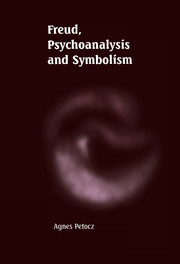Book contents
- Frontmatter
- Contents
- List of figures
- Preface
- Introduction
- Part One Exegesis and Extraction
- 1 From disorder towards the focus of inquiry
- 2 The ‘Freudian Narrow’ (FN) theory of symbolism
- 3 The ‘symbol’ in Freud's early writings (1893–1899)
- 4 Continuation and elaboration (1900–1913)
- 5 The ‘core years’ for the FN theory (1914–1917)
- 6 The treatment of symbolism in Freud's later writings (1918–1940)
- Part Two Consolidation and Defence
- Epilogue
- List of references
- Index
4 - Continuation and elaboration (1900–1913)
Published online by Cambridge University Press: 22 October 2009
- Frontmatter
- Contents
- List of figures
- Preface
- Introduction
- Part One Exegesis and Extraction
- 1 From disorder towards the focus of inquiry
- 2 The ‘Freudian Narrow’ (FN) theory of symbolism
- 3 The ‘symbol’ in Freud's early writings (1893–1899)
- 4 Continuation and elaboration (1900–1913)
- 5 The ‘core years’ for the FN theory (1914–1917)
- 6 The treatment of symbolism in Freud's later writings (1918–1940)
- Part Two Consolidation and Defence
- Epilogue
- List of references
- Index
Summary
Despite Freud's claim, in the preface to the second (1908) edition of the Studies on Hysteria, that the germs of his theory of symbolism were already present in the first (1893–5) edition of that work, he himself contributed to the myth of a discontinuity between his early and later writings on symbolism; on a number of occasions he asserted that it was only late in his work that he had come to a ‘discovery’ of unconscious symbolism and to an appreciation of its important role. This assertion, apart from contradicting the above claim, is belied by what was shown in the previous chapter, i.e., that in Freud's early writings there is already a substantial basis for a theory of symbolism, including a number of important themes which were never subsequently abandoned. It is also at odds with evidence from an examination of the development of Freud's treatment of symbolism in the writings which followed this earliest period, evidence which indicates that the continuity with his earlier writings was maintained by the retention and elaboration of those general themes. However, the examination also allows some insight into why Freud made the assertion.
- Type
- Chapter
- Information
- Freud, Psychoanalysis and Symbolism , pp. 56 - 97Publisher: Cambridge University PressPrint publication year: 1999



